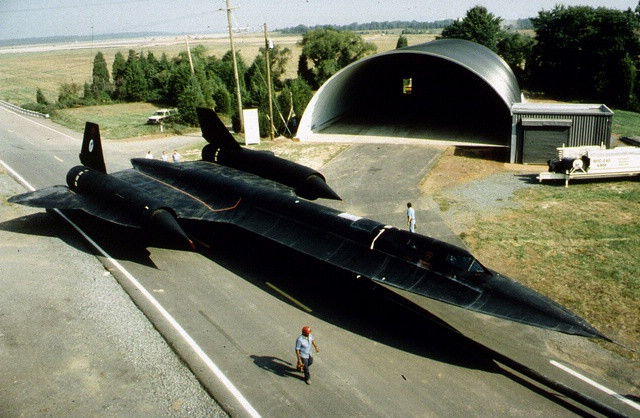The Lockheed SR-71 Blackbird remains an aviation legend, renowned for its unparalleled speed and operational altitude. This marvel of engineering wasn’t just fast; it flew incredibly high, pushing the boundaries of atmospheric flight. So, how high does an SR-71 fly? The answer is astonishingly high, placing its pilots in a realm closer to astronauts than typical aviators.
To truly understand the SR-71’s altitude capabilities, we need to delve into the factors that made it a high-flying sentinel. The SR-71 was designed to operate at altitudes of 80,000 to 85,000 feet (approximately 24,384 to 25,908 meters). This is significantly higher than commercial airliners, which typically cruise at around 30,000 to 40,000 feet. At such altitudes, the SR-71 was not only above the reach of most interceptor aircraft of its time but also experienced significantly reduced air resistance, contributing to its blistering speed.
 SR-71 Blackbird at Dulles Storage Facility
SR-71 Blackbird at Dulles Storage Facility
The extreme altitude was essential for the SR-71’s primary mission: reconnaissance. Flying at 85,000 feet allowed the Blackbird to survey vast swathes of territory, capturing detailed imagery without being easily detected or intercepted. This operational height also meant pilots had to contend with conditions akin to space. The air is incredibly thin, and the risk of decompression at such altitudes is lethal. This is why SR-71 pilots were required to wear specialized pressure suits, essentially modified spacesuits, offering life support in the event of cabin pressurization loss. These suits highlight the extreme environment the Blackbird operated in, blurring the lines between aviation and space exploration.
Reaching and maintaining such altitudes demanded groundbreaking engineering. The SR-71’s engines were crucial. They were designed to operate continuously with a supersonic afterburner, a key factor in achieving and sustaining Mach 3+ speeds at high altitudes. The diamond pattern visible in the SR-71’s jet exhaust is a direct result of these supersonic afterburners, creating shock waves that are a visual testament to the immense power required for high-altitude, high-speed flight. Furthermore, the extreme temperatures generated by hypersonic flight at such altitudes – reaching 600°F (316°C) on external surfaces – necessitated the use of titanium alloy for the aircraft’s skin. This exotic material shielded the internal aluminum airframe from the intense heat, a testament to the innovative materials science employed in the SR-71’s construction to withstand the rigors of its high-altitude mission profile. Even the tires were specially engineered with aluminum mixed into the latex and filled with nitrogen to prevent melting under extreme conditions and pressure, a detail often overlooked but critical for safe operation at such demanding altitudes and speeds.
The SR-71’s altitude wasn’t just a number; it was a critical component of its strategic advantage and a symbol of its technological prowess. Its ability to fly at 85,000 feet, faster than any other air-breathing jet aircraft, secured its place in aviation history and solidified its legacy as a high-altitude reconnaissance icon. The Museum’s SR-71 itself holds multiple world records, including a record-setting final flight from Los Angeles to Washington D.C., further emphasizing its exceptional high-speed, high-altitude capabilities. From its pressure-suited pilots to its titanium skin and supersonic afterburners, every aspect of the SR-71 was meticulously designed to conquer the challenges of flight at the very edge of the Earth’s atmosphere.

